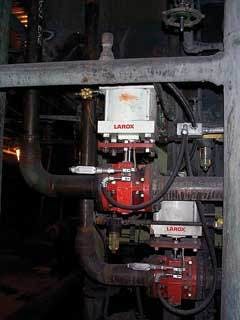Pinch valves from Larox Flowsys are often used in lime slurry service.
Click here to enlarge imageThe reason lime is so difficult for many types of equipment is that lime does not dissolve but rather is suspended in solution. Lime particles are also extremely jagged. Any cracks, crevices or void areas become natural collection or settling points for the lime particles. The particles settle and then solidify to create an extremely heavy scale. If these areas happen to be around moving parts of, for instance, a valve or a pump then they may no longer be free to move. Lime also forms scale on the interior of piping, with the pipe’s diameter shrinking smaller and smaller as the scale increases.
Process equipment selected for use in lime slurry should be as free as possible of void areas or collection points. The products should also have the capability to self clean themselves when lime build-up occurs. A typical lime slurry control loop and pumping station can be a significant draw on maintenance dollars if the wrong products are selected. Full port is a grand idea in lime slurry. Even a small crack or crevice can cause countless hours of maintenance and downtime.
Pinch Valves
Depending on design, pinch valves perform well in lime slurry service. They incorporate a straight through design which has no pockets or cavities for material collection points. Also, since the rubber sleeve flexes it creates a self cleaning effect. As the rubber sleeve starts to close the rubber is stretched, thus flaking the scale build up. Then, as the sleeve closes further, the line pressure and fluid velocity increase across the restricted area creating a washing effect of the scaled material. Virtually no lime is left on the valve’s sleeve surface.
Not all pinch valves operate in the correct manor to insure this occurs. Some pinch valves only pinch from the top, pushing the top of the rubber sleeve all the way to the bottom. In these valves the bottom part of the sleeve does not flex, so build up may remain on the lower section. The best pinch valve would be one that is dual closing on the valve’s centerline. This insures the best cleaning of the rubber sleeve.
One caution is that pinch valves are manufactured from rubber compounds. There are thousands of variations in rubber manufacturing. An example would be when you go to a tire store and buy a 40,000 mile rated tire or an 80,000 mile rated tire. There is a difference in price and also a difference in performance. You can certainly find similar situations from one pinch valve manufacturer to another.
If you have tried pinch valves many years ago and were unhappy with the performance then, don’t give up on the technology. There are reputable pinch valve manufacturer’s with quality products. Your first unsuccessful purchase was probably an inferior product.
Ball, plug valves
If you determine a ball valve or a plug valve is the right choice for your lime system then there are multiple steps you should take. First of all, if the valve is actuated then you should double the manufacturer’s required torque of the actuator to be able to break through the scale build up that will occur on these valves. Secondly you should have flushing ports in the valve body to allow flushing of the ball or plug cavity area after every operation.
You should not use a Teflon seated valve. Teflon will be destroyed in a very short order in lime slurry. The scale build up on the plug and or ball in these valves acts like a wrecking ball to most polymeric seats. Stellite seats and stellite coating on the plug or ball would provide the best result in lime slurry service. If the manufacturer offers a scraping seat, then that would be wise.
Gate, Knife Gate Valves
With gate and knife gate valves you must be ready for a certain amount of leakage that will occur through these types of valves. Even the best types do not stay tight forever. Probably the best selection would be a knife gate with a cutting edge to the gate which can cut and/or break up lime scale. Still, this seating area will be an accumulation point for the lime slurry and will likely create problems. A hard faced or stellited gate or leading edge of the gate should be employed.
Again actuator torques on these valves should be increased substantially. The knife or the gate will be subjected to scale build up which will be dragged through their packing area. This will most likely result in leakage from the packing over time. The dragging of scale through this area will require the additional actuator forces to insure proper closing and opening of the valve.
About the Author:
Todd Loudin is president of Larox Flowsys Inc., Linthicum



